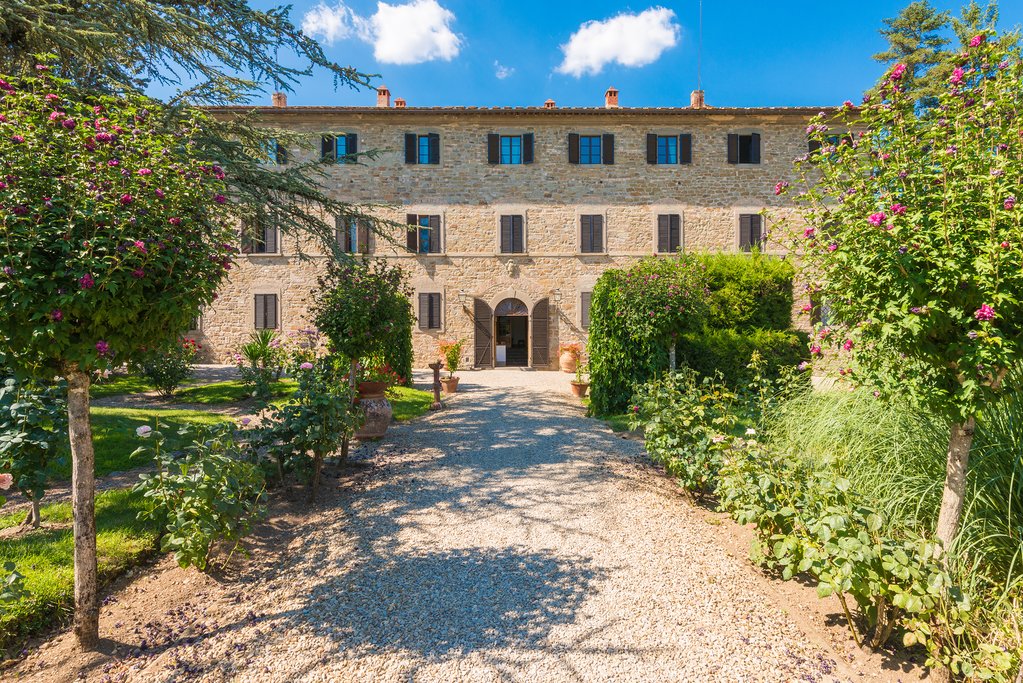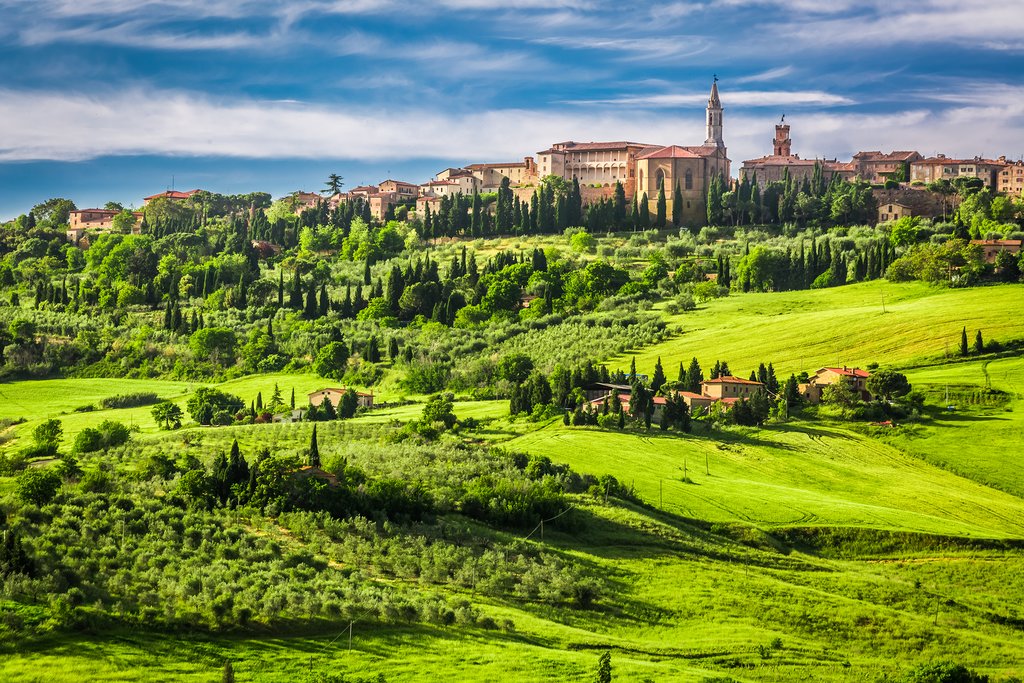Discover Tuscany
Renaissance art, Gothic cathedrals, world-class wine and olive oil, Michelangelo's "David," charming hilltop towns, beautiful beaches: the popular Italian region of Tuscany has so much to offer travelers.
Cycle around Florence, rent a car and explore the wine region of Chianti, take a dip in the Tyrrhenian Sea, or wander through the fairytale-like streets of Tuscany's medieval villages. No matter how much time you spend, you'll probably wish you had a few more days. Read on for more on the region's top attractions and advice on where to stay and what to eat.
Interested in a one-week trip around the region? Discover the best of Tuscany in this 7-day itinerary.
Planning Your Visit

When to go
Tuscany is great to visit at any time of year. Generally speaking, spring months offer the nicest weather—May is a peak travel time all around the region, and hotel rates go up—while summer can be hot and sticky, but pleasant along the coast. Expect tour groups, school groups, and larger crowds at major tourist destinations throughout the summer, as well.
On the other hand, summertime brings one of the most exciting events in Tuscany every year. The Palio, a famous horse race around Siena's Piazza del Campo, enlivens the city from June 29th to July 2nd and August 13th to August 16th. Find out more here about visiting Tuscany in August.
Autumn is the rainiest season in Tuscany, but it's a good time to visit because fewer tourists are around, the weather is moderate, and some hotels offer lower prices. Winter is also a fine choice, so long as you're prepared for the possibility of snow and cold weather. Bear in mind that December is a busy tourist month in Tuscany, especially around the holidays, but crowds drop off in January. This article has more details on visiting Tuscany in December.
Have two weeks to spend in Tuscany? Check out this 14-day trip idea.
Getting there
Florence, as the capital city, is a hub of travel. No matter where you're headed in Tuscany, you may make connections in the city—and Florence is easily connected to Rome by both high-speed trains (the ride lasts one hour and 20 minutes) and local trains (which take several hours, depending on the train and how many stops it makes). From Florence's busy Santa Maria Novella train station, which happens to be a gorgeous example of 1930s-era Italian Modernist architecture, you can catch a train almost anywhere in the region.
It's worth noting that local buses can be a good option for arriving in some destinations: Siena Mobilità, for example, runs buses directly from Rome's Fiumicino Airport to Siena (the trip takes about four hours).
Many travelers rent cars in Florence or Rome for self-guided adventures of Tuscany. Check out Auto Europe for rates, and be sure to pay extra for a GPS: you'll be glad you have it once you're out on Tuscany's winding roads.
Chat with a local specialist who can help organize your trip.
Highlights & Activities

The capital of Tuscany, Florence, is a fascinating destination and the perfect place to get oriented before exploring the region's smaller towns and the surrounding wine country. Visit the central Duomo cathedral, take a bicycle tour through the historic center, stop into the Galleria dell'Accademia to see Michelangelo's iconic "David" statue, see works by Da Vinci, Raphael, and Botticelli in the Uffizi Gallery, and walk along Ponte Vecchio bridge at sunset for classic views over the Arno River.
An easy day trip from the city—and a place that's worth spending a week in, if you have time—is Chianti. The wine region is full of historic wineries like Antinori and Badia a Coltibuono where you can taste wines from Chianti Rufina to Chianti Colli Fiorentini. Visit castles, churches, and outdoor markets in towns like Greve and Poggibonsi, and leave plenty of time for leisurely lunches and dinners served with wine and locally produced cheese and olives.
Where else to go? The options are many: there are too many lovely Tuscan towns and villages to name. Siena, named a UNESCO World Heritage Site, is world-renowned for its Gothic cathedral, while San Gimignano is famous for its Middle Age-era towers. The scenic drive between Pienza and Montepulciano, cutting through the region of Val D’Orcia, is a road trip you won't soon forget. And beach lovers shouldn't miss a trip to the Tuscan coast, where the pretty beaches of the Maremma region—not to mention excellent seafood—await travelers.
Find out more about Siena here, and make the most of a short stay in Florence with this ultimate guide and recommendations for 24 hours in the city.
Where to Stay

Many travelers choose to base themselves in Florence and day-trip from the capital city to historic towns and wine country. There's no shortage of excellent hotels, guesthouses, and apartment rentals to choose from: top choices in the high-end category include J.K. Place Firenze and Villa Cora, while Palazzo Guadagni is a great option for budget-minded travelers. Apartments Florence and Housing in Florence are both good resources for renting a local apartment.
Alternatively, base yourself in one of Tuscany's larger towns, like Siena, where guesthouses and hotels like Palazzo Ravizza and Garden Hotel Siena cater to families. Staying in a B&B smaller village, or at an agriturismo (country hotel set on a working farm) in the hills, are other possibilities that offer visitors an in-depth view of the Tuscan lifestyle. Try Fonte Bertusi guesthouse near Pienza, where you'll get to know the Italian family (and probably Italian guests) during your stay, or for something more rustic, nearby Agriturismo Cretaiole, where olive oil, wine, and cured meats are produced on the premises. Wine tasting and olive harvesting are both activities you can join in.
Read about the best boutique hotels in Florence here.
Where to Eat

A range of delicious foods, drinks, and condiments are locally produced in Tuscany, from excellent red wines and extra-virgin olive oil in Chianti to chestnuts, fresh pecorino cheese, and truffles foraged in the forest. Whether you're eating gelato and pizza on the street or reserving weeks ahead for one of Florence's top restaurants, it's hard to go wrong with food in Tuscany: just steer clear of any establishments that are full of tourists and look for places where Italians are eating or having a glass of wine.
Classic Tuscan dishes to look for include bistecca alla fiorentina (Florentine-style seak, served rare with olive oil and salt), panzanella (bread salad with tomatoes, cucumber, and onion), pappa al pomodoro (a thick tomato and basil soup with bread), and for dessert, castagnaccio (cake made with chestnut flour, raisins, pine nuts, and rosemary).
There are so many ways to experience Tuscany's culinary traditions. Go on a food tour with or sip and swirl your way around Chianti with Tuscan Wine Tours—or rent a car on go on a self-guided adventure of wine country. In Tuscan towns, opt for a simple meal at a family-run trattoria, splurge on a seafood feast at an elegant ristorante (restaurant), or join in the food and fun at a humble sagra, something like a community dinner (look for advertisements around town).
For more information on Tuscan cuisine, see this article.
